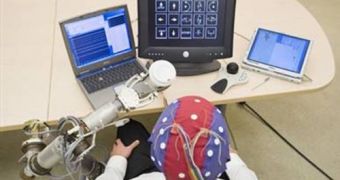University of South Florida (USF) researchers are currently refining a new device that is meant to assist amyotrophic lateral sclerosis (ALS) sufferers in moving various objects around and even lifting heavy stuff. It consists of a robotic arm mounted on the side of a wheelchair, and a software that basically reads the mind of the person manning the apparatus. The patient's brain impulses are translated by the software into command lines for the robotic arm, which in turn executes the task.
But the most important thing that the new device facilitates is the fact that ALS patients may soon be able to perform daily routine tasks, which are otherwise impossible to do on account of their condition. They progressively lose control of motor neurons, which handle voluntary muscle movement. The condition is fatal in most cases, and, as it progresses, it causes muscular atrophy throughout the body.
“We aren't reading people's thoughts. This is the first time a person with severe disabilities like ALS can perform daily activities for themselves,” USF scientist Redwan Alqasemi, who is a member of the team that has developed both the hardware and the software components of the new system, explains. The team also includes USF experts Rajiv Dubey and Emanuel Donchin.
The robotic arms work fairly simple. Through electroencephalogram (EEG) readings, doctors can usually understand what ALS patients are trying to express, even though they cannot speak or move so as to make their thoughts known. Taking advantage of the extensive EEG knowledge they have, the USF team have set to accomplish their goal by monitoring the particular brain wave known as P300, which only lasts about a third of a second.
With the new system, the ALS patient sits in the wheelchair and thinks about the direction they want to move the robotic arm in. A series of arrows flashes on the screen, and when the people see the one pointing in their desired direction, their brains start emitting P300 waves. These are promptly recorded by an EEG machine, which is hooked to a computer. The software deciphers the information, and then sends the commands to the arm, which moves in the desired direction.
At this moment, the researchers say, the machine can lift about four pounds, but “every pound you take off the robotic arm is another pound of payload that can be lifted,” Alqasemi adds. In future versions, the researchers maintain, the robot will be able to sustian even more weight and also move faster than it does now. Currently, it takes about 7 seconds for a command to make its way through from the brain to the arm, but the scientists are looking at drastically reduce that.

 14 DAY TRIAL //
14 DAY TRIAL //